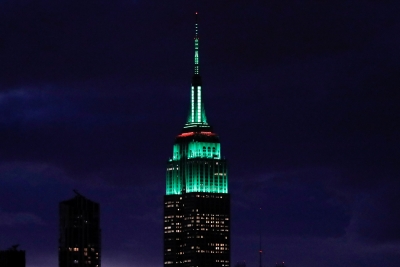
The Empire State Building only started becoming profitable in the 1950s, when it was finally able to break even for the first time. At the time, mass transit options in the building’s vicinity were limited compared to the present day. Despite this challenge, the Empire State Building began to attract renters due to its reputation. A 222-foot (68 m) radio antenna was erected on top of the towers starting in 1950, allowing the area’s television stations to be broadcast from the building.
However, despite the turnaround in the building’s fortunes, Raskob listed it for sale in 1951, with a minimum asking price of $50 million. The property was purchased by business partners Roger L. Stevens, Henry Crown, Alfred R. Glancy and Ben Tobin. The sale was brokered by the Charles F. Noyes Company, a prominent real estate firm in upper Manhattan, for $51 million, the highest price paid for a single structure at the time. By this time, the Empire State had been fully leased for several years with a waiting list of parties looking to lease space in the building, according to the Cortland Standard. That same year, six news companies formed a partnership to pay a combined annual fee of $600,000 to use the building’s antenna, which was completed in 1953. Crown bought out his partners’ ownership stakes in 1954, becoming the sole owner. The following year, the American Society of Civil Engineers named the building one of the “Seven Modern Civil Engineering Wonders”.
In 1961, Lawrence A. Wien signed a contract to purchase the Empire State Building for $65 million, with Harry B. Helmsley acting as partners in the building’s operating lease. This became the new highest price for a single structure. Over 3,000 people paid $10,000 for one share each in a company called Empire State Building Associates. The company in turn subleased the building to another company headed by Helmsley and Wien, raising $33 million of the funds needed to pay the purchase price. In a separate transaction, the land underneath the building was sold to Prudential Insurance for $29 million. Helmsley, Wien, and Peter Malkin quickly started a program of minor improvement projects, including the first-ever full-building facade refurbishment and window-washing in 1962, the installation of new flood lights on the 72nd floor in 1964, and replacement of the manually operated elevators with automatic units in 1966. The little-used western end of the second floor was used as a storage space until 1964, at which point it received escalators to the first floor as part of its conversion into a highly sought retail area.
Picture Credit : Google




